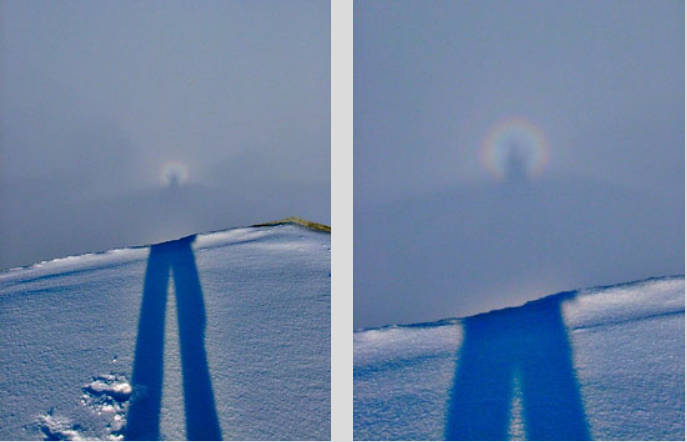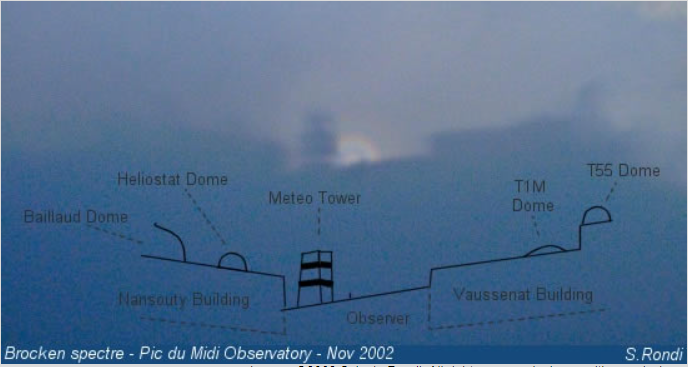Brocken spectre
The Brocken Spectre: A Mysterious Atmospheric Phenomenon
Have you ever found yourself hiking in the mountains, only to be startled by a strange and awe-inspiring sight? One such phenomenon is the Brocken Spectre, a captivating optical illusion that has fascinated observers for centuries. Named after the Brocken, the highest peak in the Harz Mountains of Germany, where it was first observed, this phenomenon occurs when an individual's shadow is cast onto a cloud or fog bank below them. The shadow appears greatly magnified and encircled by a colorful halo, creating a breathtaking spectacle.
Understanding the Mechanics of the Brocken Spectre
The Brocken Spectre is a result of a combination of atmospheric conditions and the observer's position in relation to the sun. When sunlight shines from behind an observer, their shadow is projected onto the cloud or fog below. The droplets of water or ice crystals in the cloud act as tiny mirrors, reflecting and refracting the sunlight. This scattering of light creates the halo effect around the shadow, while the magnification occurs due to the convergence of the rays of light.
Factors Influencing the Appearance of the Brocken Spectre
Several factors contribute to the appearance of the Brocken Spectre, making it a relatively rare occurrence. These factors include:
- Weather conditions: The presence of clouds or fog is essential for the phenomenon to be visible. Clear skies do not provide the necessary background for the shadow to be cast upon.
- Sun's position: The sun must be at a low angle in the sky, typically within 20 degrees of the horizon. This positioning allows for optimal projection and magnification of the shadow.
- Observer's position: The observer must be positioned above the cloud or fog layer, such as on a mountain or high-altitude location. This elevation is crucial for casting a shadow onto the mist below.
The Brocken Spectre and Other Related Optical Phenomena
The Brocken Spectre shares similarities with other atmospheric optics phenomena, which further add to its mystique. Some related phenomena include:
- Glory: The colorful halo surrounding the magnified shadow in the Brocken Spectre is known as a glory. This optical effect is caused by the diffraction, interference, and scattering of light as it interacts with water droplets or ice crystals.
- Fogbow: In addition to the Brocken Spectre, a fine fogbow can sometimes be observed. Similar to a rainbow, a fogbow is formed when sunlight is refracted and reflected by tiny water droplets in a fog bank, creating a white or pale-colored arc.
Historical Significance and Cultural References
The Brocken Spectre has captivated people throughout history, leading to various cultural references and legends. One notable mention is in Johann Wolfgang von Goethe's famous play "Faust," where the protagonist encounters the phenomenon atop the Brocken mountain. The eerie and ethereal nature of the Brocken Spectre has also given rise to folklore and superstitions surrounding the mountain.
Capturing the Brocken Spectre
Witnessing a Brocken Spectre firsthand is a rare and remarkable experience. To capture this phenomenon in photographs, certain techniques can be employed:
- Use a wide-angle lens: A wide-angle lens helps capture the entirety of the shadow and its halo, providing a more immersive representation of the spectacle.
- Position yourself correctly: Ensure you are standing at the right location above the cloud or fog layer to cast a clear and well-defined shadow.
- Adjust exposure settings: Due to the stark contrast between the bright halo and the shadow, it may be necessary to adjust exposure settings to capture both elements accurately.
Conclusion
The Brocken Spectre is an enchanting atmospheric phenomenon that continues to captivate observers worldwide. Its occurrence relies on a combination of atmospheric conditions, the sun's position, and the observer's location. With its colorful halo and magnified shadow, the Brocken Spectre stands as a testament to the beauty and complexity of our natural world. Whether witnessed in person or captured through the lens of a camera, this elusive spectacle leaves a lasting impression on all who encounter it.

Brocken shadow and glory at the Pic du Midi Observatory altitude 2877m in the French Haute Pyrenees. These images by Sylvain Rondi (site) taken in November '02 illustrates the continuity of shadow from the observer's feet to the distant Brocken Spectre.
The shadows on the mist of the observatory towers and buildings formed their own 'Brocken Spectres'. A fine fogbow was also visible (image here).

Images ©2002 Sylvain Rondi, All rights reserved, shown with permission
Note: this article has been automatically converted from the old site and may not appear as intended. You can find the original article here.
Reference Atmospheric Optics
If you use any of the definitions, information, or data presented on Atmospheric Optics, please copy the link or reference below to properly credit us as the reference source. Thank you!
-
<a href="https://atoptics.co.uk/blog/brocken-spectre-5/">Brocken spectre</a>
-
"Brocken spectre". Atmospheric Optics. Accessed on November 26, 2024. https://atoptics.co.uk/blog/brocken-spectre-5/.
-
"Brocken spectre". Atmospheric Optics, https://atoptics.co.uk/blog/brocken-spectre-5/. Accessed 26 November, 2024
-
Brocken spectre. Atmospheric Optics. Retrieved from https://atoptics.co.uk/blog/brocken-spectre-5/.